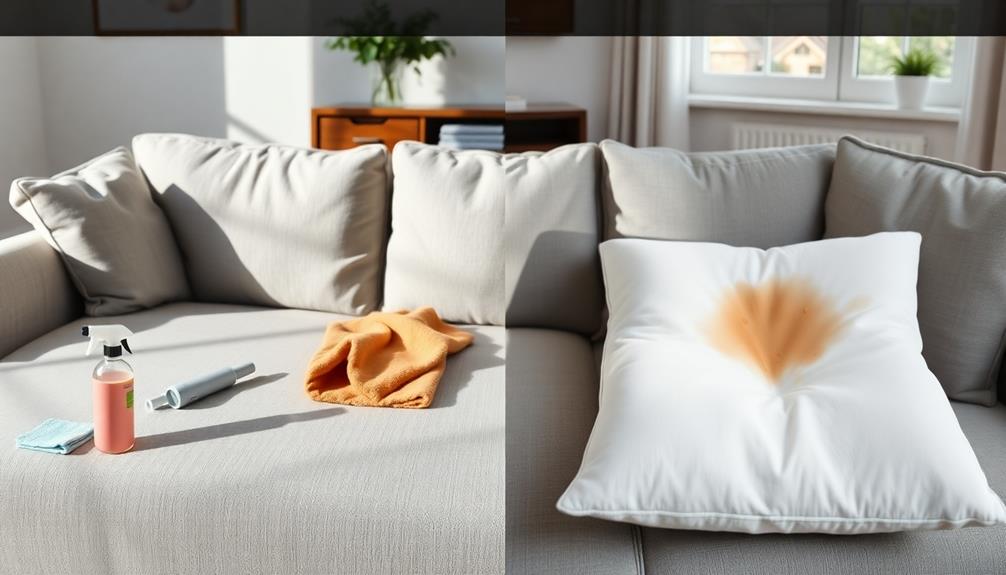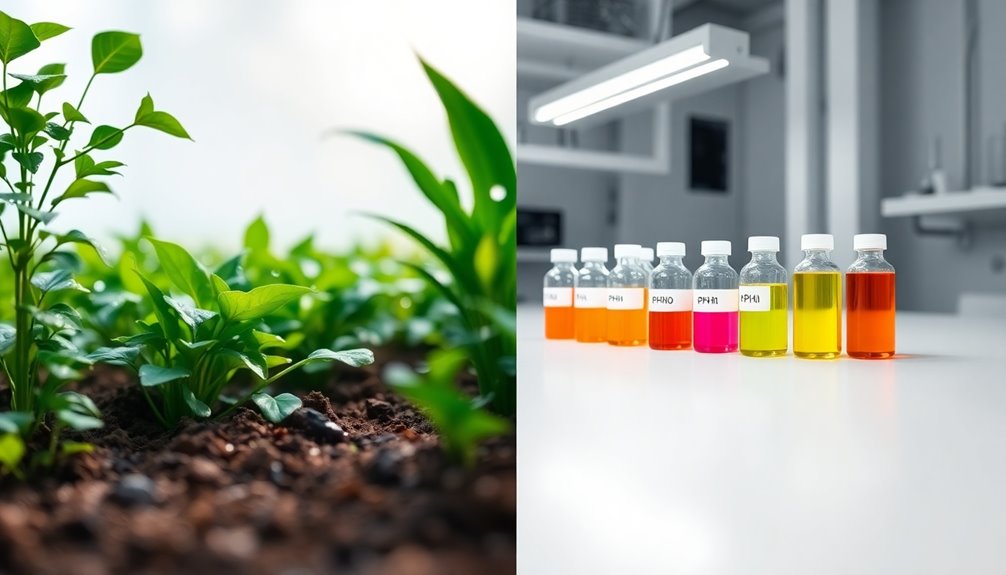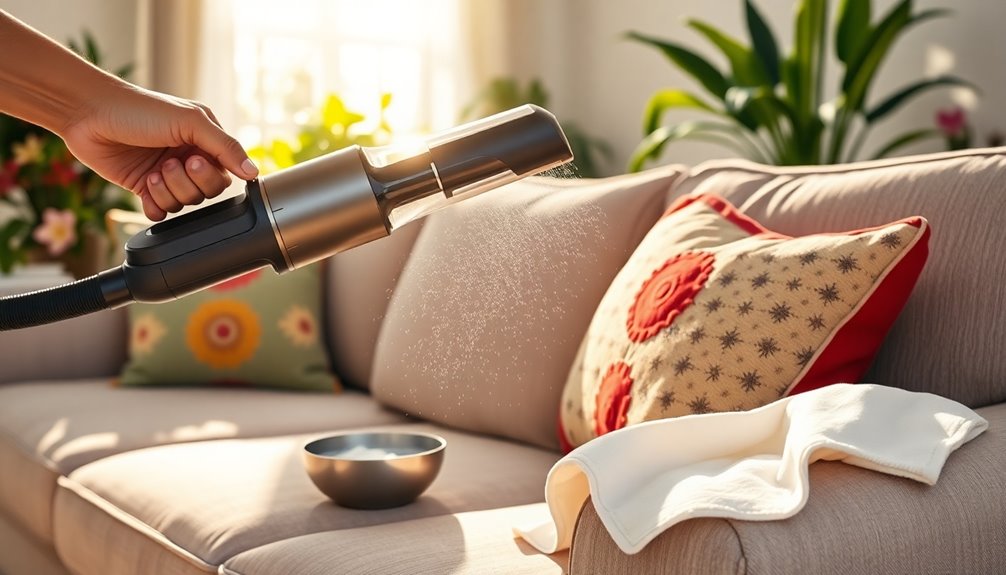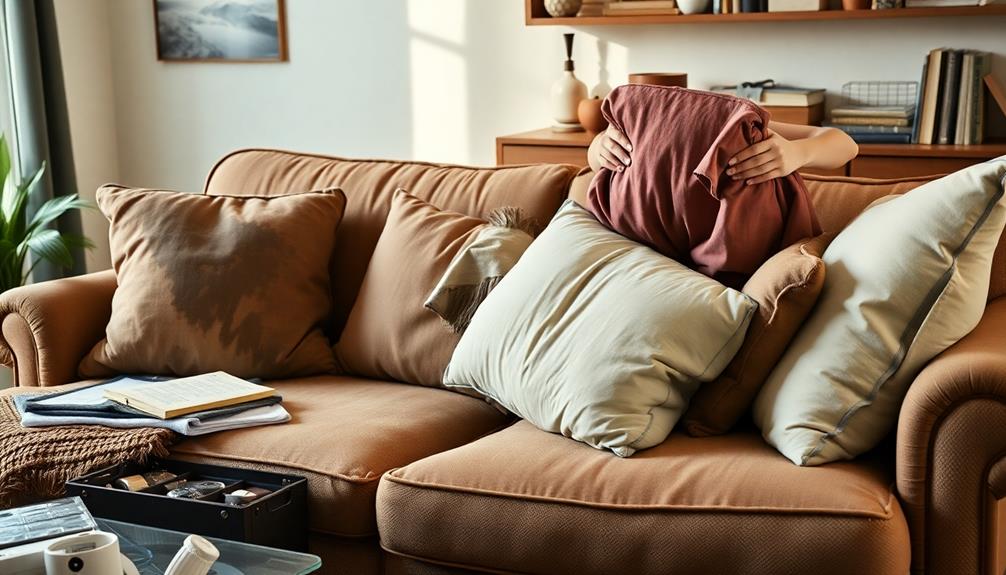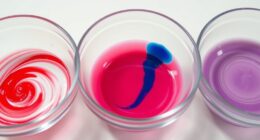To clean your polyester sofa, begin by referring to the care label for precise directions. Vacuum the surface to eliminate dust and debris, then carefully blot any spills with a clean, damp cloth. For stains, create a mixture of vinegar and dish soap, use a gentle brush to apply it, and then rinse with a damp cloth. If permitted, a steam cleaner can offer deep cleaning. Remember to allow the sofa to air dry completely and fluff the cushions once done. Consistent upkeep is crucial, and there is additional information to explore on maintaining the pristine condition of your sofa.
Key Takeaways
- Check the care label for cleaning codes and recommended methods before starting the cleaning process.
- Regularly vacuum the sofa to remove dust and pet hair, ensuring a clean surface.
- Blot spills immediately with a clean, damp cloth to prevent stains from setting in.
- Use a mixture of vinegar and dish soap for gentle stain removal and odor neutralization.
- Schedule professional cleaning every 1-2 years to maintain the polyester fabric's appearance and longevity.
Understanding Polyester Fabric
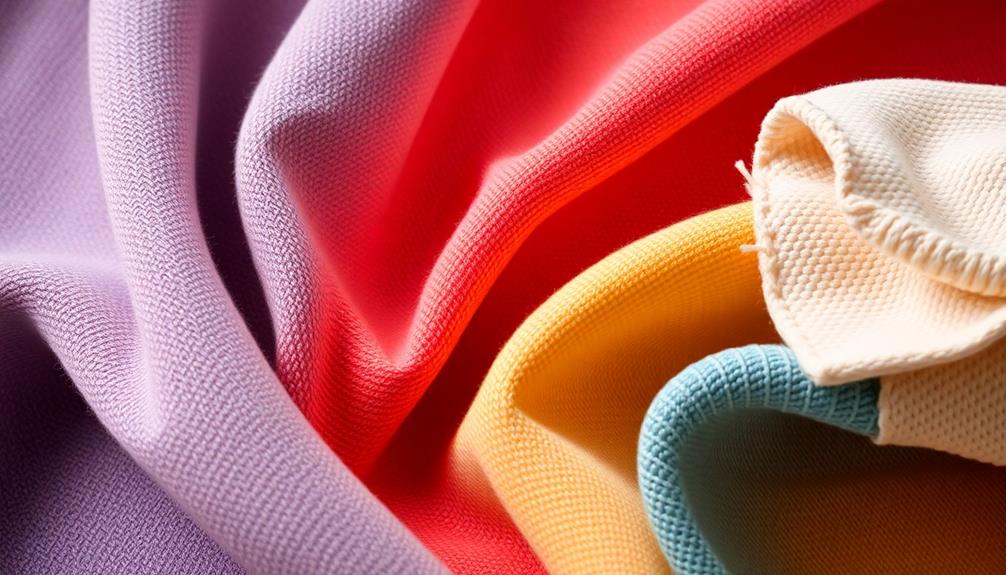
Polyester fabric is often chosen for its durability and versatility, making it a popular option for sofas and other upholstery. This synthetic material, technically known as polyethylene terephthalate (PET), is renowned for its resistance to fading, ensuring that your upholstery maintains vibrant colors over time.
When you opt for polyester, you're selecting a fabric that stands up to daily wear and tear while offering a variety of textures, from faux leather to velvet. Additionally, many modern polyester sofas are designed with advanced cleaning features, making them even more appealing for busy households. For example, some models come equipped with best vacuums for dust removal to help maintain a clean and allergen-free environment.
Although polyester is a non-biodegradable textile, it can be 100% recycled, contributing to sustainable practices in both the fashion and furniture industries. Its cleaning advantages also make it appealing; polyester is generally easy to maintain, allowing you to keep your upholstery looking fresh and clean with minimal effort.
However, one thing to keep in mind is that polyester isn't as breathable as natural fibers, which could lead to discomfort in warm or humid environments.
Environmental Impact of Polyester

When you choose polyester for your sofa, it's important to evaluate its environmental impact.
While polyester is non-biodegradable and contributes to plastic pollution, it's also 100% recyclable, offering a way to reduce waste.
Investing in sustainable materials can enhance your home's value and contribute to long-term financial security, just as diversifying your retirement portfolio does through options like Gold IRA Rollovers.
Recycling Polyester Materials
Recycling polyester materials plays an essential role in reducing environmental impact and promoting sustainability. Since polyester is 100% recyclable, you can actively contribute to these efforts by choosing products made from repurposed materials. The recycling process transforms post-consumer plastic bottles into fibers, considerably lowering the environmental impact compared to making virgin polyester from petroleum.
Additionally, understanding the importance of budgeting for sustainable choices can help you make more environmentally friendly purchases without overspending.
By opting for recycled polyester, you're helping cut down on landfill waste and reducing the reliance on new, petroleum-based materials. In fact, about 60% of recycled polyester comes from post-consumer waste, showcasing its potential in sustainability. One of the biggest advantages is the energy savings; using recycled polyester can save up to 75% of energy compared to producing new fibers.
This recycling not only mitigates pollution but also promotes a circular economy, where materials are continuously reused without depleting natural resources. When you choose synthetic fabrics made from recycled polyester, you're making a positive difference for the environment.
Non-biodegradable Concerns
As you consider the materials in your home, it's important to recognize the long-term environmental concerns associated with polyester. This synthetic material, derived from petroleum, is non-biodegradable, leading to significant waste accumulation. Moreover, the reliance on non-renewable resources for its production raises questions about sustainability and environmental responsibility.
Here are some key points to keep in mind:
1. Waste Accumulation: Approximately 60% of polyester produced is used in textiles, which can take hundreds of years to decompose in landfills.
2. Recycling Rates: While polyester is technically recyclable, only about 14% of plastic clothing items are actually recycled, highlighting a gap in effective recycling practices.
3. High Energy Consumption: The production of polyester involves high energy consumption, contributing to greenhouse gas emissions and exacerbating climate change.
Additionally, the environmental impact of materials such as Gold IRAs can serve as a contrasting example of investing in more sustainable assets.
4. Sustainable Practices: To mitigate these environmental concerns, adopting sustainable practices, such as using recycled polyester and eco-friendly production methods, is essential.
Sustainable Manufacturing Practices
Sustainable manufacturing practices in polyester production are vital for reducing its environmental impact. Since polyester is derived from petroleum, its production relies heavily on fossil fuels, contributing to environmental degradation and greenhouse gas emissions.
However, you can make a difference by choosing products made from recycled PET (rPET), which is sourced from plastic bottles. This not only conserves resources but also minimizes waste in landfills. Additionally, understanding the financial environment can help you make informed decisions about investing in eco-conscious products.
By opting for durable polyester fabrics, you guarantee longer product life cycles, which means fewer replacements and reduced environmental waste.
Eco-conscious brands, like Transformer Table, prioritize responsible sourcing of polyester from managed resources, thereby reducing the ecological footprint of their products. These brands focus on sustainable manufacturing practices that aim to address the challenges posed by non-biodegradable materials.
When you choose items made with recycled PET, you support a circular economy that repurposes materials instead of relying on virgin resources. This shift is vital for resource conservation and helps combat the negative impacts of traditional polyester production.
Advantages and Disadvantages
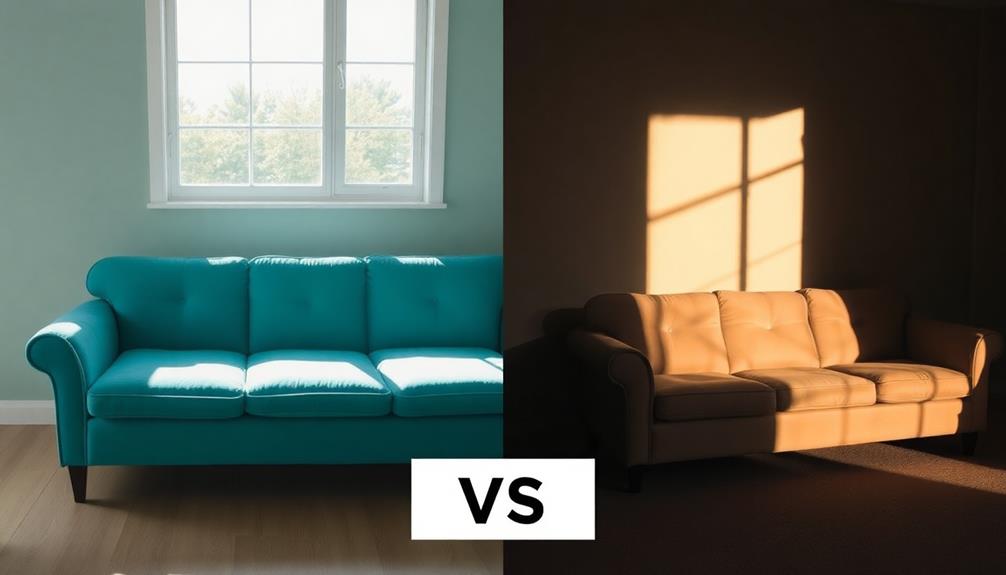
When choosing a polyester sofa, you'll find both benefits and drawbacks to weigh.
On one hand, these couches are durable, easy to clean, and budget-friendly. Additionally, they can be a good option for families with children due to their resilience against spills and stains, making them practical for everyday use.
development influenced by biological factors can also affect comfort preferences in furniture.
On the other hand, they can be less breathable and may retain odors, which might affect your comfort.
Benefits of Polyester Couches
Polyester couches are often praised for their durability, making them an excellent choice for households with kids and pets. These synthetic couches offer several benefits that make them appealing for everyday use.
Additionally, polyester's low maintenance nature means you won't have to worry about mold and mildew buildup, as it naturally resists these issues, ensuring your couch stays fresh even in humid environments mold and mildew resistance.
- Durable: Polyester is tough and designed to withstand wear and tear, especially in high-wear areas of your home.
- Easy to Clean: Stains don't stand a chance against polyester. Its stain-resistant properties mean you can quickly wipe away spills.
- Mold and Mildew Resistance: This fabric naturally resists mold and mildew, ensuring your couch stays fresh even in humid environments.
- Low Maintenance: With polyester, you won't spend hours maintaining your couch. Its longevity means it retains shape and structure, reducing the need for frequent replacements.
Additionally, polyester is 100% recyclable, making it a more sustainable choice compared to other synthetic fabrics.
Drawbacks of Polyester Couches
While enjoying the benefits of a polyester couch, it's important to reflect on some drawbacks that come with this synthetic fabric. Although polyester is durable and resistant to mold and mildew, making it great for high-traffic areas, it's less breathable than natural fibers. This lack of breathability can lead to discomfort in hot or humid environments, as the fabric doesn't effectively absorb moisture.
Additionally, maintaining a clean environment is essential, as dust and allergens can accumulate on fabrics, similar to the importance of air purifier maintenance for indoor air quality.
Another concern is that polyester fabric may retain odors more than breathable materials, meaning you might find yourself cleaning it more frequently to maintain freshness.
Additionally, while it's a cost-effective option, the limited temperature regulation can make these couches unsuitable for particularly humid climates.
Even high-quality polyester can show wear over time, especially in high-traffic zones, leading to the need for periodic maintenance and cleaning.
Cleaning Preparation Steps
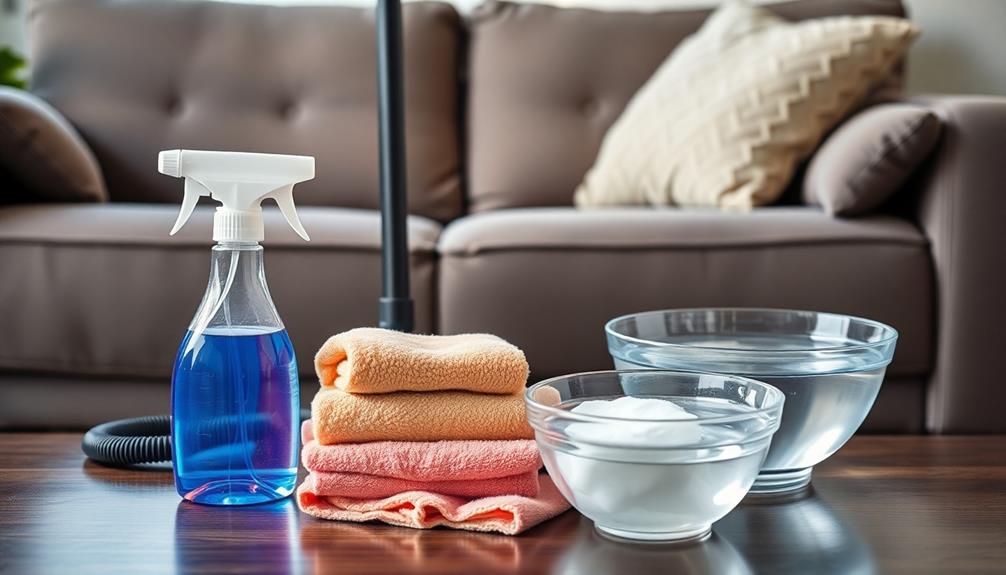
How can you affirm your polyester sofa is cleaned effectively? Start by following these vital cleaning preparation steps to guarantee the best results.
1. Check the care label: Look for specific cleaning codes (W, S, SW, X) that indicate the appropriate cleaning methods and products for your sofa. Understanding these codes is fundamental, as different fabrics require different approaches to avoid damage.
For example, the importance of cleaning codes guarantees you choose the right cleaning method.
2. Gather cleaning supplies: Collect essential items such as a vacuum with an upholstery attachment, mild detergent, a soft-bristle brush, and clean microfiber cloths. This guarantees you have everything needed for a thorough clean.
3. Inspect the sofa: Carefully examine the fabric for any visible stains, dirt, or debris. Before you start cleaning, remove loose dirt with a dry brush or vacuum to make the process easier. Pay extra attention to crevices and corners where dust and crumbs often accumulate. If you’re unsure of the fabric type, check the manufacturer’s label for instructions, including potential warnings on specific cleaning methods. If the tag suggests dry cleaning, you can research “how to dry clean sofa” to safely tackle the task without damaging the material.
4. Prepare the area: Make sure you're working in a well-ventilated area to avoid inhaling harmful fumes from cleaning products and to help the sofa dry more quickly.
Quick and Deep Cleaning Methods
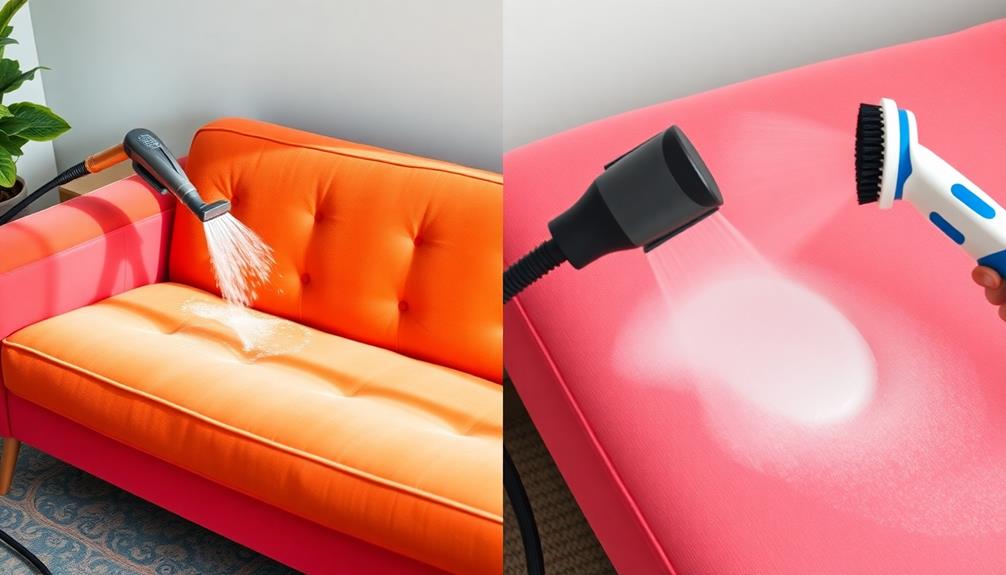
With your cleaning preparations in place, it's time to explore effective methods for keeping your polyester sofa looking fresh. For a quick clean, regularly vacuum your polyester couch using an upholstery attachment to eliminate dust, dirt, and pet hair. A lint roller can be a handy tool for added convenience.
If spills occur, immediately blot the affected area with a clean, damp cloth to absorb excess moisture—this helps prevent permanent stains. Additionally, consider using essential oils like peppermint or eucalyptus for their antimicrobial properties, which can freshen up your upholstery and promote a cleaner living space essential oils for cleaning.
For deep cleaning, always check the care label for cleaning codes. If your sofa allows, use a steam cleaner with temperature controls to lift embedded dirt and stains without damaging the fabric.
When spot cleaning, create a cleaning solution with mild detergent and water. Apply it to the stain and gently blot without rubbing, then rinse the area with a damp cloth.
After any cleaning, allow your sofa to air dry completely in a well-ventilated space. Fluff the cushions afterwards to restore their shape and appearance.
Effective Cleaning Solutions
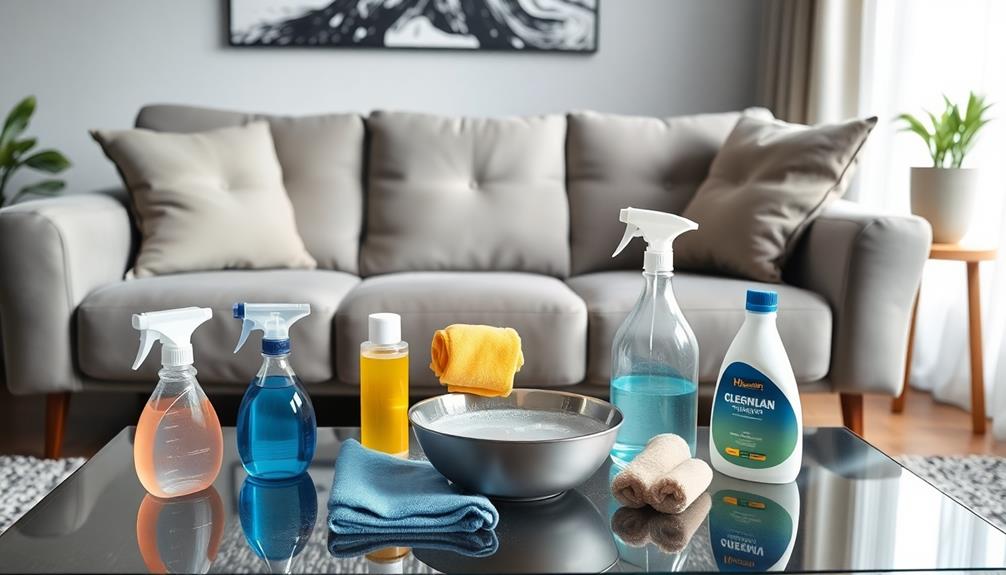
When it comes to keeping your polyester sofa clean and fresh, choosing the right cleaning solutions is crucial. The right solutions can help you effectively remove stains without damaging the fabric.
Here are some effective cleaning solutions to take into account:
- Vinegar and Dish Soap Mixture: Combine white vinegar and dish soap with warm water for a gentle yet effective solution. This can lift stubborn stains while protecting the polyester fibers.
- Baking Soda: Sprinkle baking soda on your polyester couch to neutralize odors. Let it sit for about 30 minutes, then vacuum to remove the residue and refresh your sofa.
- Detergent Solution for Removable Covers: If your sofa has removable fabric covers, use a laundry detergent mixed with cold water. Always check care labels before washing to confirm compatibility.
- Spot Treatment with a Soft Brush: For spot cleaning, avoid oversaturating the fabric. Use a damp cloth and a soft brush to gently blot the area, lifting stains without spreading them.
Remember to test any cleaning solution on an inconspicuous area first to confirm it won't discolor your polyester couch.
Maintenance Tips for Longevity
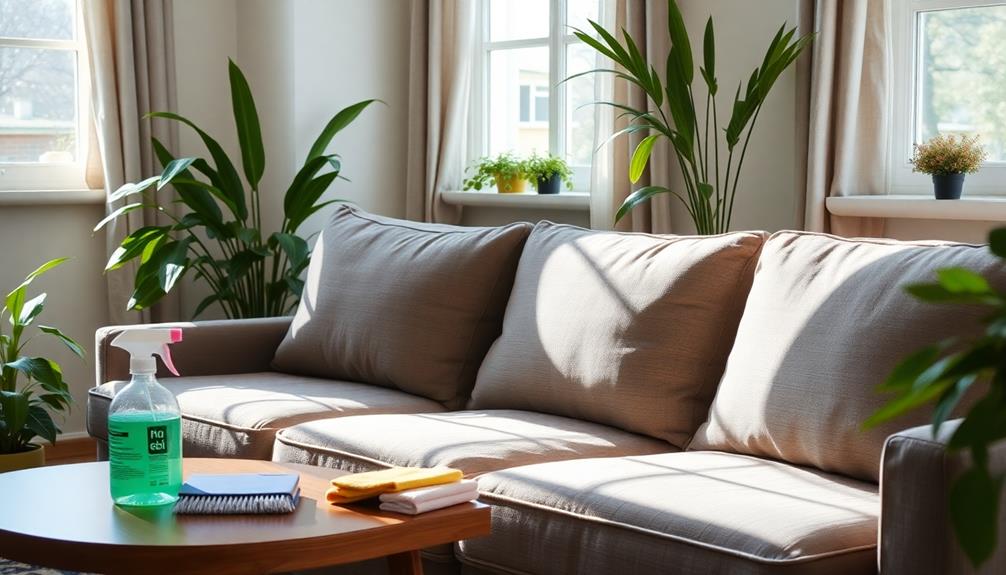
To keep your polyester sofa looking great for years, regular maintenance is essential. Start with regular vacuuming at least once a week to eliminate dust, dirt, and pet hair. This prevents buildup that can damage the fabric and affect its appearance.
When spills happen, immediately blot them with a clean, damp cloth to prevent stains from setting. Use mild detergents or natural cleaning solutions for effective spot treatments.
Don't forget to flip your reversible cushions periodically; this distributes wear evenly and helps maintain their shape. Scheduling professional cleaning every 1-2 years is vital for removing embedded dirt and ensuring fabric integrity, especially in high-traffic areas.
Additionally, make it a habit to utilize baking soda monthly to neutralize odors. Simply sprinkle it on the fabric, let it sit for 20-30 minutes, and then vacuum it off for a refreshed scent.
Professional Cleaning Considerations
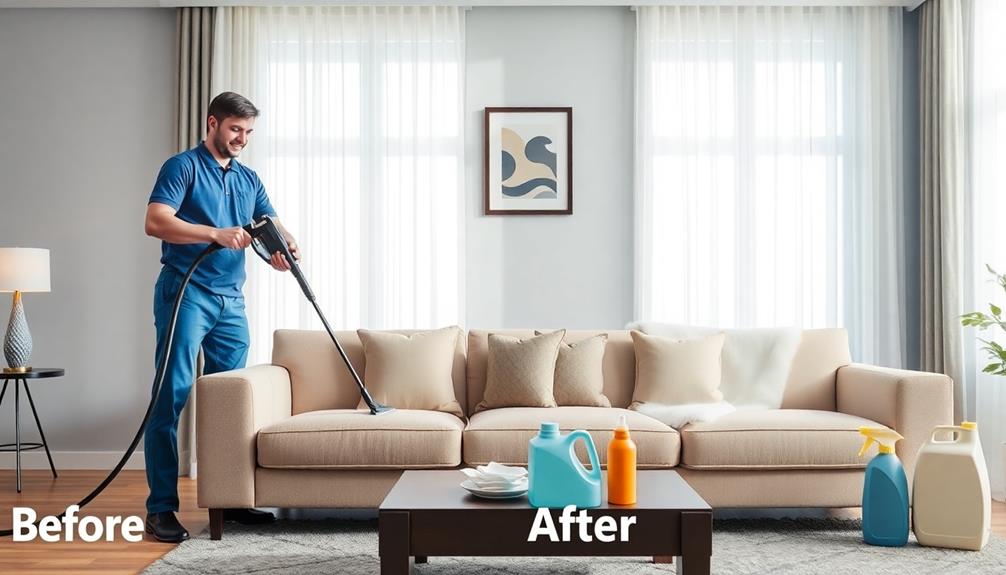
Professional cleaning plays an essential role in maintaining the appearance and longevity of your polyester sofa. Regular professional cleaning is recommended every 1-2 years, especially for sofas in high-traffic areas. This service goes beyond surface cleaning, providing a thorough cleaning that removes embedded dirt and preserves fabric integrity.
Here are some key considerations for professional cleaning:
- Expertise: Professionals use specialized equipment and cleaning solutions tailored for polyester sofas, ensuring effective cleaning without fabric damage.
- Health Benefits: Deep cleaning helps eliminate allergens and dust mites, contributing to a healthier living environment for you and your family.
- Maintenance: Scheduling professional cleaning complements your at-home care routine, enhancing both the appearance and comfort of your sofa.
- Cost-Effectiveness: Regular professional maintenance can prolong the lifespan of your sofa, reducing the need for costly replacements over time.
Frequently Asked Questions
How to Clean a 100% Polyester Couch?
To clean your 100% polyester couch, check the care label for instructions. Vacuum weekly to remove debris, spot clean stains with a mild detergent, and consider steam cleaning for a deeper clean, testing a small area first.
How to Clean 100% Polyester Fabric?
Cleaning 100% polyester fabric might seem challenging, but it's easier than you think. Start by checking care labels, vacuum regularly, and spot clean with a mild detergent to keep it looking fresh and vibrant.
What Is the Cleaning Code for Polyester Sofas?
The cleaning code for polyester sofas indicates the safest cleaning methods. If you see "W," use water-based solutions; "S" means solvent-based cleaners are necessary. Always check the care label before cleaning to avoid damage.
Can You Use Dish Soap on a Polyester Couch?
Think of dish soap as a gentle rain on your polyester couch. You can definitely use it, but always test a hidden spot first to avoid any unwanted surprises. It's your couch, treat it right!
Conclusion
In the grand scheme of your home, your polyester sofa deserves a little pampering. By following the right cleaning methods, you can refresh its look and extend its life, ensuring it remains a cozy haven for years to come. Think of it as giving your sofa a spa day—every fabric deserves that touch of care! So, roll up your sleeves and treat your sofa to the cleaning it craves; it'll thank you with comfort and style.
